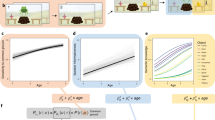Abstract
Previous studies have described children’s acquisition of language as reflecting either a referential or an expressive style. A multivariate approach, characterizing “referentiality” and “expressivity” as partially dissociable dimensions, is advantageous because it allows children to vary along one dimension as they vary along another, allowing children to have high or low degrees of both characteristics simultaneously. The present study applies multivariate techniques to an “exploratory” sample of 87 children, all of whom were 20 months old, and by subsequently validating the exploratory phase with 56 of the original children seen one month later. Using parental reports to assess children’s multiword productions, exploratory factor analyses revealed two correlated dimensions of language style which indeed reflected referential and expressive characteristics. Confirmatory factor analyses “confirmed” these factors in the test sample. This two-dimensional model of language acquisition was superior to a unidimensional, general linguistic competence model. There is also strong short-term stability for both dimensions across the one-month period.
Similar content being viewed by others
References
Bates E., Benigni, L., Bretherton, I., Camaioni, L., & Volterra, V. (1979).The emergence of symbols. New York: Academic Press.
Bates E., Bretherton, I., & Snyder, L. (1988).From first words to grammar: Individual differences and dissociable mechanisms. Cambridge, MA Cambridge University Press.
Bates E., Marchman, V., Thal, D., Fenson, L., Dale, P., Reznick J.S., Reilly, J., & Hartung, J. (1994). Developmental and stylistic variation in the composition of early vocabulary.Journal of Child Language, 21, 85–124.
Bauer, P.J. (1985).Referential and expressive styles in lingustic and nonlinguistic domains: A longitudinal examination. Unpublished doctoral dissertation. Miami University, Oxford, OH.
Bentler, P.M. (1989).EQS: Structural equations program manual. Los Angeles: BMDP Statistical Software.
Bloom, L. (1970).Language development: Form and function in emerging grammars. Cambridge, MA MIT Press.
Bloom, L., Lightbown, P., & Hood, L. (1975). Structure and variation in child language.Monographs of the Society for Research in Child Development. 40(2, Serial No. 160).
Bretherton, I., McNew, S., Snyder, L., & Bates E. (1983). Individual differences at 20 months: Analytic and holistic strategies in language acquisition.Journal of Child Language, 10, 293–320.
Chomsky, N. (1957).Syntactic structures. The Hague: Mouton.
Chomsky, N. (1986).Knowledge of language. New York Praeger Special Studies.
Dixon, W.E. (1990).Individual differences in three domains of cognitive development. Unpublished doctoral dissertation. Miami University, Oxford, OH.
Dore, J. (1974). A pragmatic description of early language development.Journal of Psycholinguistic Research, 4, 423–430.
Fodor, J. (1983).The modularity of mind. Cambridge, MA; MIT Press.
Gardner, H. (1983).Frames of mind: The theory of multiple intelligences. New York: Basic Books.
Goldfield, B., & Reznick, J.S. (1990). Early lexical acquisition: Rate, content, and the vocabulary spurt.Journal of Child Language, 17, 171–183.
Hardy-Brown, K. (1983). Universals and individual differences: Disentangling two approaches to the study of language acquisition.Developmental Psychology, 19, 610–620.
Lieberman, P. (1991).Uniquely human: The evolution of speech. thought. and selfless behavior. Cambridge, MA: Harvard University Press.
Lieven, E. (1978). Conversations between mothers and young children: Individual differences and their possible implications for the study of language learning. In N. Waterson & C. Snow (Eds.),The development of communication: Social and pragmatic factors in language acquisition (p. 173–187). New York: Wiley.
Nelson, K. (1973). Structure and strategy in learning to talk.Monographs of the Society for Research in Child Development, 38(1–2, Serial No. 149).
Nelson, K. (1975). The nominal shift in semantic-syntactic development.Cognitive Psychology, 1, 461–479.
Nelson, K. (1981). Individual differences in language development: Implications for development and language.Developmental Psychology, 17, 171–183.
Nelson, K. (1985).Making sense: The acquisition of shared meaning. San Diego: Academic Press.
Peters, A. (1977). Language learning strategies: Does the whole equal the sum of the parts?Language, 53, 560–573.
Ramer, A. (1976). Syntactic styles in emerging language.Journal of Child Language, 3, 49–62.
Rescorla, L. A. (1984). Individual differences in early language development and their predictive significance.Acta Paedologica, 1, 97–116.
Shore, C. (1981).Getting it together: An exploration in cognitive capacities related to multisymbol combinations. Unpublished doctoral dissertation, University of Colorado, Boulder, CO.
Sternberg, R.J. (1988).The triarchic mind. New York: Viking.
Studdert-Kennedy, M. (1991). A note on linguistic nativism. In RH. Hoffman & D.S. Palermo (Eds.),Cognition and the symbolic processes: Applied and ecological perspectives. Hillsdale, NJ: Erlbaum.
Wolf, D., & Grollman, S.H. (1982). Ways of playing: Individual differences in imaginative style. In D.J. Pepler & K.H. Rubin (Eds.),The play of children: Current theory and research. Basel, Switzerland: Karger.
Author information
Authors and Affiliations
Rights and permissions
About this article
Cite this article
Dixon, W.E., Shore, C. Children’s acquisition of language: General linguistic competence or dimensions of style?. Current Psychology 14, 54–68 (1995). https://doi.org/10.1007/BF02686874
Accepted:
Issue Date:
DOI: https://doi.org/10.1007/BF02686874




